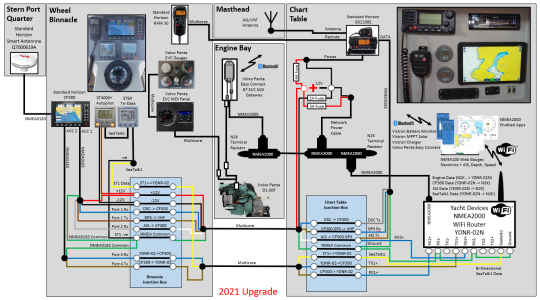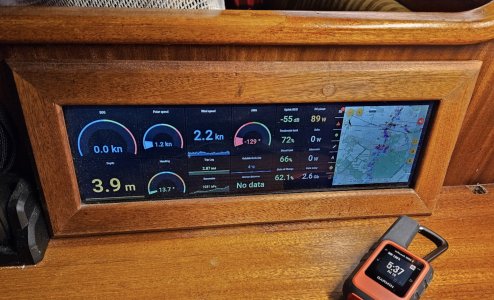Baggywrinkle
Well-Known Member
I'm reasonably tech savvy, my day job is designing interfaces for automotive systems communicating over CAN, FlexRay and SomeIP ... so NMEAxxxx and SignalK is not something I don't understand.
On my boat I did have an Android Tablet which collected and displayed data from a Volvo engine, a Raymarine (SeaTalk1) network, a few NMEA0183 components and some NMEA2000 devices ... and the device which enabled it all was a Yacht Devices NMEA2000 WiFi Router (YDNR-02N) combined with an Android Tablet running a few apps. ... See Pic.

Since then, I have played around with a Raspberry Pi running VenusOS for various Victron components and setting up the Pi was reasonably straightforward .....
... however it was well beyond the capabilities of all of my sailing friends. They thought it was great that I had a Raspberry Pi that looked like a Victron GX Touch but I lost them as soon as I tried to explain the hardware they needed and how to install VenusOS with the necessary packages ... pointing them at the YouTube videos by Tobi, https://www.youtube.com/@tobisreallifeskillswithtobi, which are some of of the best I've seen, especially when combined with the SetupHelper Package were no help, they were completely lost and overwhelmed.
So IMO, a standardised message catalogue is very interesting, but if it is not adopted by the major manufacturers of marine HW then it will remain a niche ..... a bit like Linux on PC hardware. NMEA0183 and NMEA2000 messages are already more standardised than automotive busses so from my point of view these two worlds are good enough as they are.
At the end of the day, the ability to decode all the protocols from the various marine suppliers already exists, so display and control are available from 3rd parties over their proprietary systems anyway, just buy the right kit and it will work. The majority of my sailing friends just buy plotters and components off the shelf if the vendor says it will do what they want and any attempt to look below the surface just gets them confused.
On my boat I did have an Android Tablet which collected and displayed data from a Volvo engine, a Raymarine (SeaTalk1) network, a few NMEA0183 components and some NMEA2000 devices ... and the device which enabled it all was a Yacht Devices NMEA2000 WiFi Router (YDNR-02N) combined with an Android Tablet running a few apps. ... See Pic.

Since then, I have played around with a Raspberry Pi running VenusOS for various Victron components and setting up the Pi was reasonably straightforward .....
... however it was well beyond the capabilities of all of my sailing friends. They thought it was great that I had a Raspberry Pi that looked like a Victron GX Touch but I lost them as soon as I tried to explain the hardware they needed and how to install VenusOS with the necessary packages ... pointing them at the YouTube videos by Tobi, https://www.youtube.com/@tobisreallifeskillswithtobi, which are some of of the best I've seen, especially when combined with the SetupHelper Package were no help, they were completely lost and overwhelmed.
So IMO, a standardised message catalogue is very interesting, but if it is not adopted by the major manufacturers of marine HW then it will remain a niche ..... a bit like Linux on PC hardware. NMEA0183 and NMEA2000 messages are already more standardised than automotive busses so from my point of view these two worlds are good enough as they are.
At the end of the day, the ability to decode all the protocols from the various marine suppliers already exists, so display and control are available from 3rd parties over their proprietary systems anyway, just buy the right kit and it will work. The majority of my sailing friends just buy plotters and components off the shelf if the vendor says it will do what they want and any attempt to look below the surface just gets them confused.

